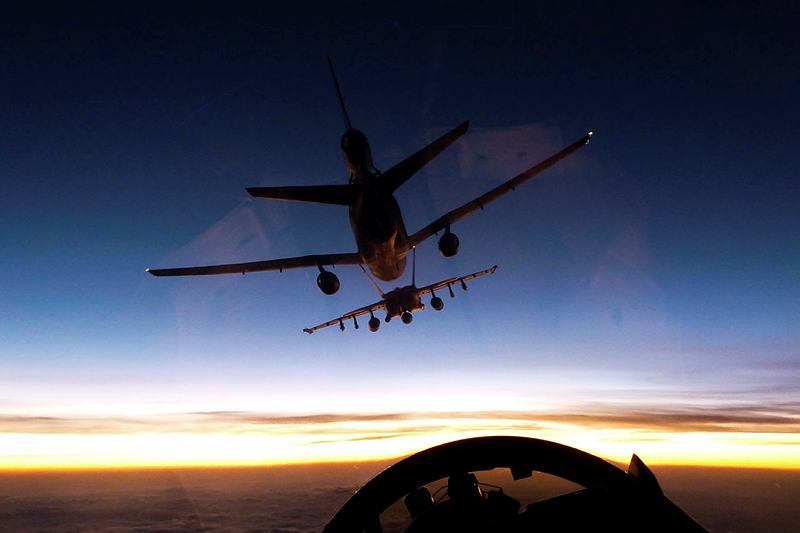Middle East operations: an update
Posted By David Johnston on February 13, 2015 @ 11:00
 [1]It’s hard to fathom how the extremist’s sales pitch works when we continue to hear reports of daesh atrocities against innocent civilians, including enslavement and rape of women, mass executions—including of their own fighters who’ve tried to leave the group—and barbaric acts such as the immolation of the Jordanian pilot last week.
[1]It’s hard to fathom how the extremist’s sales pitch works when we continue to hear reports of daesh atrocities against innocent civilians, including enslavement and rape of women, mass executions—including of their own fighters who’ve tried to leave the group—and barbaric acts such as the immolation of the Jordanian pilot last week.
To use a metaphor more apt for the bushfire season, these messages of hatred are being fuelled by events in Syria and Iraq. If terrorist spot-fires are to be avoided, we have to focus efforts on back-burning. Some of that back-burning has come in the form of 2,000 airstrikes in Iraq and Syria that have bought time and space for the Iraqi Security Forces (ISF) to reconstitute, improve their tactical skills and to launch counter-offensives against daesh emplacements.
The quick wins by daesh in the first 9 months of last year are now largely halted in Iraq thanks in part to the air campaign. Across Iraq, while not all provinces have returned to Iraqi control, there have been tactical gains. Those have included:
- Anbar, where the security situation remains contested as ISF with the support of Sunni tribes are currently fighting for control of the Province’s largest city, Ramadi. Daesh maintains control of Fallujah, and ISF continues to contest the approaches to the city. The Haditha Dam on the Euphrates River remains under Iraqi government control and the daesh threat to capture this piece of strategic infrastructure has diminished;
- Bayji, where the ISF has cleared through to the vital oil refinery ending 48 days of isolation for the Counter-Terrorism Service personnel that have defended the facility;
- Erbil, where Kurdish Peshmerga forces continue to clear a village in and around the Kisik Junction—denying daesh a major supply route into Syria; and
- Mosul, where shaping operations involving air strikes are supporting efforts for future ISF operations.
In developing the Iraqi Security Force’s military competencies, the coalition—led by the US—has established a number of training sites. The Australian Special Operations Task Group (SOTG) has been working with the Iraqi Special Operations Forces from within the Baghdad area and outside the city but within an Iraqi Army operating base.
Training provided by the SOTG has included 46 students trained in combat-casualty care, 220 Iraqi Security Force personnel have received Explosive Hazards Awareness training and additional urban combat skills training has been provided to 600 Special Tactical Unit (STU) students. That training is bringing the capability of the Counter Terrorism Service (CTS) to a level where they have improved confidence in their own combat capabilities—this is the key to their willingness to fight.
Within the CTS is a cell that is training military working dogs. A trained dog-handler from the SOTG has been working with their K-9 team to train and increase the number of dogs that can identity Improvised Explosive Devices (IEDs) and to neutralise threats in a non-lethal manner. This capability has quickly expanded and will soon add to the ability of the Iraqi forces to safely engage threats at close quarter while also safely identifying explosive devices.
In support of ISF ground operations, the Advise and Assist mission has also coordinated the provision of coalition air-strike operations to support Iraqi ground offensives. As of 27 January, there were approximately 3,750 Iraqi Security Forces under training by the international coalition.
Australian aircraft have also continued to plan and conduct regular air strikes against daesh targets in Iraq in support of ISF operations on the ground. Australia’s rate of effort has contributed to 13% of coalition air strikes. In January, the Royal Australian Air Force deployed 53 laser-guided and GPS-guided bombs while the tempo over December was higher with 61 500-pound bombs deployed. Ninety percent of these air strikes have been against daesh fighters with the remaining strikes focused on daesh leadership and logistics.
Since air operations commenced in September, more than 2,200 air hours have been flown by the F/A-18F, 815 hours flown by the E-7 Wedgetail and more than 1,100 hours have been flown by the KC-30 air-to-air refueller. The KC-30 has also dispensed 5,000 tonnes of fuel to aircraft from the United States, United Kingdom, France and Canada. The Wedgetail’s crew made history with a record 16 hour 18 minute command-and control-mission over Iraq, requiring two mid-air refuelling tasks to maintain on-station duties.
From the air and against Iraqi and Kurdish ground forces, daesh forces are suffering significant casualties. While daesh’s military campaign is not anywhere near defeated, with an estimated force of between 20,000 to 31,500 fighters, on Tuesday we saw a tweet calling on would be jihadists to ‘hurry up and join’ the terrorist organisation (Courier Mail, 11 February 2015). Their marketing campaign might be successful to date but joining has dire consequences with approximately 8,000 extremists killed to date. While body count is no measure of success, it’s a powerful warning to would-be jihadists.
The ADF’s efforts in combating extremism is part of a whole of government and coalition effort. For ADF personnel, their long hours of work and high levels of professionalism ensure that our contribution is valued and meaningful. We remain focused on helping the Iraqi people defend against a threat that has global consequences.
Vice Admiral David Johnston is the Chief of Joint Operations of the Australian Defence Force. Image courtesy of Department of Defence [2].
Article printed from The Strategist: https://www.aspistrategist.org.au
URL to article: https://www.aspistrategist.org.au/middle-east-operations-an-update/
URLs in this post:
[1] Image: http://www.aspistrategist.org.au/wp-content/uploads/2015/02/20141208raaf0000000_0003.jpg
[2] Department of Defence: http://images.defence.gov.au/20141208raaf0000000_0003.jpg
Click here to print.